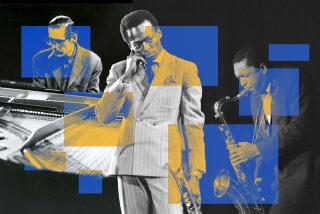Alice Coltrane, 69; performer, composer of jazz and New Age music; spiritual leader
Alice Coltrane, the jazz performer and composer who was inextricably linked with the adventurous musical improvisations of her late husband, legendary saxophonist John Coltrane, has died. She was 69.
Coltrane died Friday at West Hills Hospital and Medical Center in West Hills, according to an announcement from the familyâs publicist. She had been in frail health for some time and died of respiratory failure.
Though known to many for her contributions to jazz and early New Age music, Coltrane, a convert to Hinduism, was also a significant spiritual leader and founded the Vedantic Center, a spiritual commune now located in Agoura Hills. A guru of growing repute, she also served as the swami of the San Fernando Valleyâs first Hindu temple, in Chatsworth.
For much of the last nearly 40 years, she was also the keeper of her husbandâs musical legacy, managing his archive and estate. Her husband, one of the pivotal figures in the history of jazz, died of liver disease July 17, 1967, at the age of 40.
A pianist and organist, Alice Coltrane was noted for her astral compositions and for bringing the harp onto the jazz bandstand. Her last performances came in the fall, when she participated in an abbreviated tour that included stops in New York and San Francisco, playing with her saxophonist son, Ravi.
She was born Alice McLeod in Detroit on Aug. 27, 1937, into a family with deep musical roots. Anna, her mother, sang and played piano in the Baptist church choir. Aliceâs half brother Ernie Farrow was a bassist who played professionally with groups led by saxophonist Yusef Lateef and vibes player Terry Gibbs.
Alice began her musical education at age 7, learning classical piano. Her early musical career included performances in church groups as well as in top-flight jazz ensembles led by Lateef, guitarist Kenny Burrell and saxophonist Lucky Thompson.
After studying jazz piano briefly in Paris, she moved to New York and joined Gibbsâ quartet.
âAs fascinating -- and influential -- as her later music was, it tended to obscure the fact that she had started out as a solid, bebop-oriented pianist,â critic Don Heckman told The Times on Saturday. âI remember hearing, and jamming with, her in the early â60s at photographer W. Eugene Smithâs loft in Manhattan. At that time she played with a brisk, rhythmic style immediately reminiscent of Bud Powell.
âLike a few other people whoâd heard her either at the loft or during her early â60s gigs with Terry Gibbs, I kept hoping sheâd take at least one more foray into the bebop style she played so well,â he said.
She met her future husband in 1963 while playing an engagement with Gibbsâ group at Birdland in New York City.
âHe saw something in her that was beautiful,â Gibbs, who has often taken credit for introducing the two, told The Times on Saturday. âThey were both very shy in a way. It was beautiful to see them fall in love.â
Gibbs called her âthe nicest person I ever worked with. She was a real lady.â
She left Gibbsâ band to marry Coltrane and began performing with his band in the mid-1960s, replacing pianist McCoy Tyner. She developed a style noted for its power and freedom and played tour dates with Coltraneâs group in San Francisco, New York and Tokyo.
She would say her husbandâs musical impact was enormous.
âJohn showed me how to play fully,â she told interviewer Pauline Rivelli and Robert Levin in comments published in âThe Black Giants.â
âIn other words, heâd teach me not to stay in one spot and play in one chord pattern. âBranch out, open up ... play your instrument entirely.â ... John not only taught me how to explore, but to play thoroughly and completely.â
After his death, she devoted herself to raising their children. Musically, she continued to play within his creative vision, surrounding herself with such like-minded performers as saxophonists Pharoah Sanders and Joe Henderson.
Early albums under her name, including âA Monastic Trio,â and âPtah the El Daoud,â were greeted with critical praise for her compositions and playing. âPtah the El Daoudâ featured her sweeping harp flourishes, a sound not commonly heard in jazz recordings. Her last recording, âTranslinear Light,â came in 2004. It was her first jazz album in 26 years.
Through the 1970s, she continued to explore Eastern religions, traveling to India to study with Swami Satchidananda, the founder of the Integral Yoga Institute.
Upon her return she started a store-front ashram in San Francisco but soon moved it to Woodland Hills in 1975. Located in the Santa Monica Mountains since the early 1980s, the ashram is a 48-acre compound where devotees concentrate on prayer and meditation.
Known within her religious community by her Sanskrit name, Turiyasangitananda, Coltrane focused for much of the last 25 years on composing and recording devotional music such as Hindu chants, hymns and melodies for meditation. She also wrote books, including âMonumental Ethernal,â a kind of spiritual biography, and âEndless Wisdom,â which she once told a Times reporter contained hundreds of scriptures divinely revealed to her.
In 2001 she helped found the John Coltrane Foundation to encourage jazz performances and award scholarships to young musicians.
In addition to Ravi, she is survived by another son, Oren, who plays guitar and alto sax; a daughter, Michelle, who is a singer; and five grandchildren. Her son John Coltrane Jr. died in an automobile accident in 1982.
More to Read
The biggest entertainment stories
Get our big stories about Hollywood, film, television, music, arts, culture and more right in your inbox as soon as they publish.
You may occasionally receive promotional content from the Los Angeles Times.










